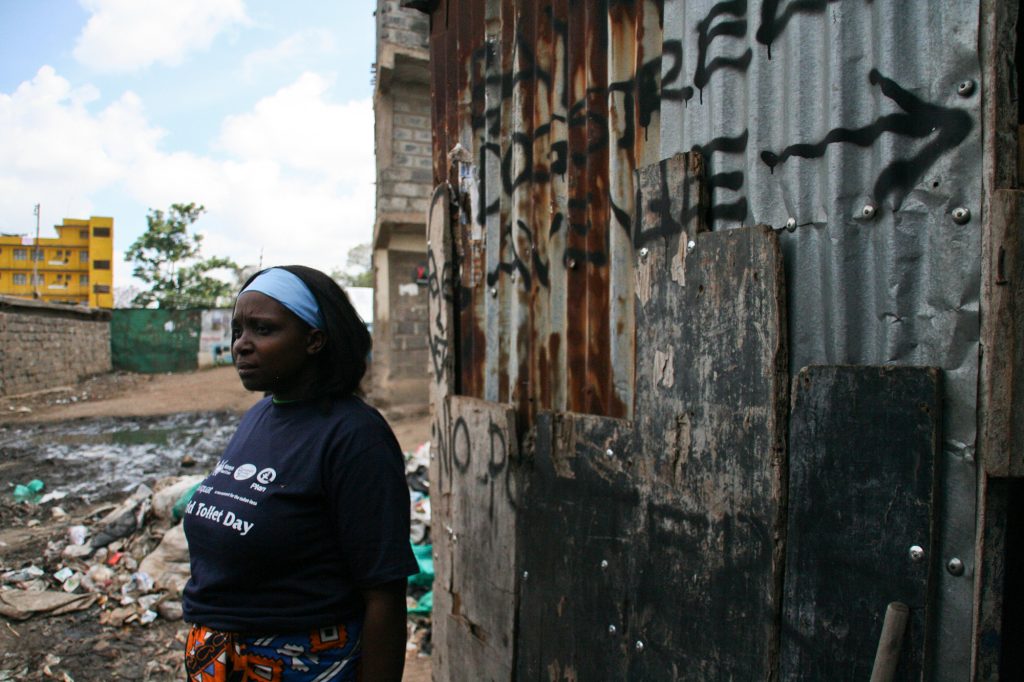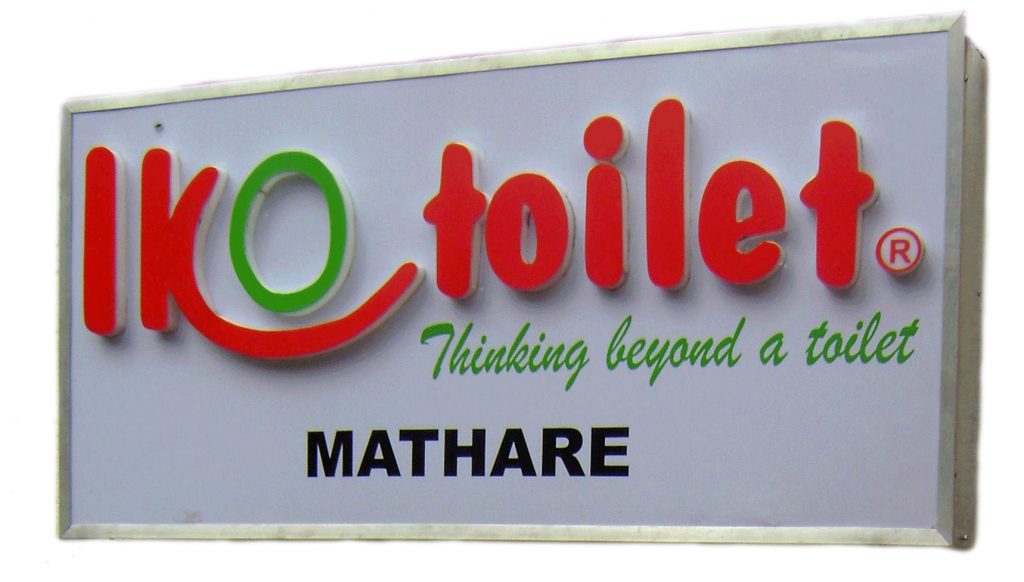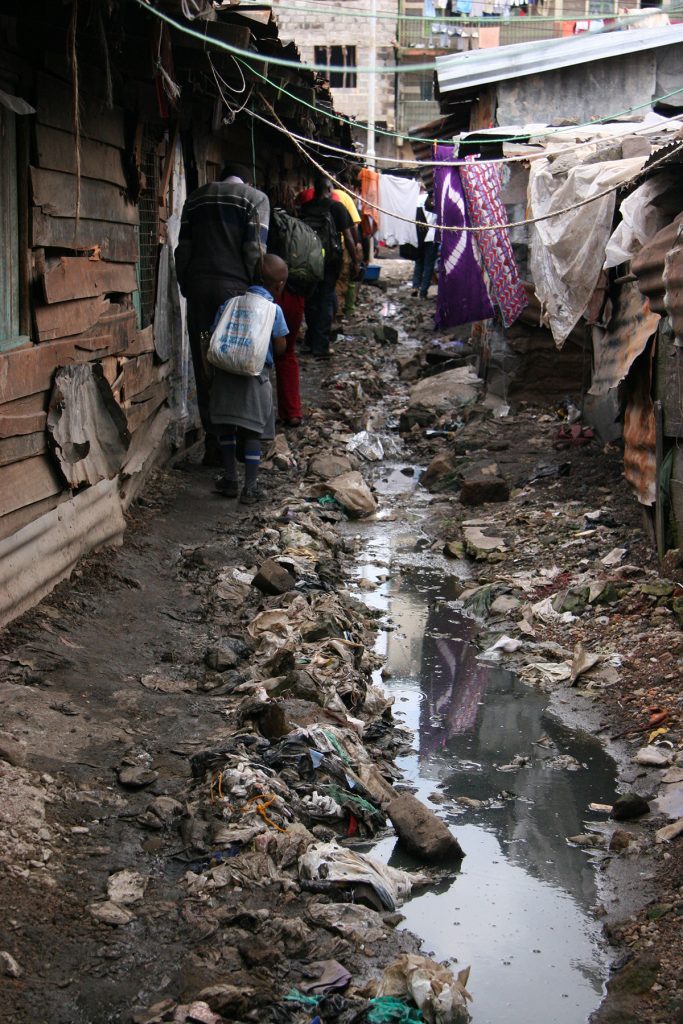The IkoToilet, meaning “Here is the toilet” in Swahili, is a Nairobi-wide public–private sanitation intervention that aims to address the lack of adequate sanitation options across the city. The core of IkoToilet’s model—pay-per-use public toilets—is by no means new. By turning the basic need into an experience of leisure and consumption, however, the IkoToilet aims to challenge the idea that the toilet is an unsuitable place to visit, use, let alone to hang around (Thieme 2010). IkoToilets are intended to provide a significant step-change in the quality of public toilets and to seed a drastic rise in common expectations concerning construction, maintenance, and cleanliness of public toilets.
Each IkoToilet facility is owned by EcoTact, a social enterprise that “invests in innovations to solve sanitation crisis in Africa and beyond.” Each IkoToilet has the same distinctive design, same construction, same color scheme, same branding, and, in theory at least, is maintained and cleaned to the same high standards. In addition to the toilets, IkoToilet facilities may also include a row of shoe-shining stations and a small kiosk for the sale of snacks and drinks that are rented out to “micro-entrepreneurs.” Each IkoToilet also includes “billboard” space, with advertising placements available above, outside, and inside the toilet. Revenue from microenterprise and advertising contributes to EcoTact’s return on investment.
Reinventing the Toilet
With more than 50% of people in the world now living in cities, one of the starkest paradoxes of modernity is reflected in the statistic that more people in the world today have access to a mobile phone than a safe and clean toilet (United Nations 2013). As such, the toilet has become both the symbolic and material locus for addressing water and sanitation poverty, framed by United Nations (UN) Sustainable Development Goal 6.
The toilet has put the “unmentionable” (George 2008) on the map of development and humanitarianism. It has concentrated calls for collective attention in a singular, tangible object. For development organizations, an emphasis on the toilet has been effective in raising a broader set of questions and problems, from the spatial, material, and embodied practices of sanitation and the concerns for personal privacy, safety, and separation from disease vectors to the diversity of toilet designs. Most important, attention to the toilet as an object has called for the design and distribution of new toilets—“little development devices”—that can provide access to improved sanitation while further deferring large-scale infrastructural development in cities already marked by considerable uneven urban planning.
In the last 10 years international concerns with water and sanitation have turned Nairobi into a laboratory for the toilet. In the city’s low-income settlements inadequate sanitation is normalized, a social fact captured by the common refrain, “Diarrhea ni kawaida (is normal)”. The toilet has become the quintessential technical development problem in search of a fix (Li 2007), with toilet projects spanning the field of design, engineering, and digital technology. The toilet sits at a confluence of concerns with infrastructure and planning, hygiene, and social patterns of cleanliness, health outcomes, and the provision of cleaning services and has come to occupy new constellations of government and nongovernmental actors. Across Nairobi development practitioners, community activists, academics, and, increasingly, social entrepreneurs (business people who identify themselves with “social innovation” or “social business”) now “give a shit” about sanitation. Here the reinvention of the toilet is no longer simply a public health imperative or an ecological design challenge; it is also a business opportunity.
In Nairobi, a combination of approaches has produced a portfolio of privatized, imperfect, but functioning alternatives to nonexistent or inadequate government infrastructure and delivery (Bohnert et al. 2016). Yet, because these interventions are all public, communal, or shared toilets, they have all been obliged to confront and work off of existing infrastructures and social norms. These interventions all depend on communities taking an active role in improving their sanitation options. They all need to work within (not necessarily presume to undo or move beyond) the very real urban constraints and pragmatic coping strategies related to compact and modular living.
These interventions have practically and rhetorically turned the toilet into a development device. A range of off-grid toilets—from Ecotact’s IkoToilet hardware-franchise model to an eco-sanitation model (Sanergy’s Fresh Life Toilet)—have shifted attention away from the possibility of large-scale networked infrastructural improvements toward the everyday micro-politics of sanitation (Thieme 2015). These toilets reflect particular claims about the ability of specific market-based interventions to address sanitation poverty and have set in motion a series of narratives that make these claims travel globally.
But what kind of toilet should be promoted?
The Sanitation Problem
In December 2009, a group of private sector individuals, nongovernmental organizations (NGOs), and community-based entrepreneurs gathered at the PanAfric Hotel in Nairobi for a meeting hosted by the World Bank’s Water and Sanitation Programme to discuss the management of public and community toilets in the city of Nairobi. “Water is life, but sanitation is dignity,” said the moderator in his opening remarks.
Two years later, in February 2011, more than 100 residents from Mathare, one of Nairobi’s oldest and largest informal settlements, gathered in a community hall for an event hosted by a citizen-led geographic information systems (GIS) mapping initiative called Map Mathare to define their priorities. Run as a participatory workshop, the breakout groups reported back with various themes that were then clustered, and finally the facilitators asked that two dominant themes be identified so all the trained community “mappers” could start plotting the GIS points of the landmarks representing these two themes. Near the end of the three-hour workshop, note cards were pinned to the wall in the front of the room representing the two preferred areas of concern within each breakout group. Each card mentioned health as one, and water and sanitation as the other.
How can the lack of adequate sanitation infrastructure in the city and especially in Nairobi’s low-income residential areas be addressed? These two events reflected the gaps in perception and experience as institutions and grassroots groups set out to address Nairobi’s “sanitation problem.”
The event held at the PanAfric Hotel stressed two points: the heightened demand for more public and community toilets, and the increasing interest in enterprise-led approaches to tackling challenges of urban poverty. Although the individuals present at the meeting came from different sectors, with the private sector as a minority, the consensus was that, as one person brazenly put it, “Shit is big business!”
In contrast, at the grassroots community event in Mathare, the issues raised stemmed from a deeper reflection. Mathare’s toilet blocks are a metonym for many of the surrounding problems related to urban services facing this mosaic of impoverished and marginalized neighborhoods. In the discussion, community members reflected on the multiple aspects of the sanitation challenge (including issues of land tenure, infrastructure, and social behavior) as well as a recognition that it would never be enough simply to agree on the need for more toilets. Here public toilets and the toilet block were part of a commons. As David Waithaka, founder of the community-based NGO Mathare Association, put it, “In Mathare there are very few things that can be said to serve the public good. There is no community hall; there is no secondary school. But one of the things that you could say, it is ours, it belongs to us, is the public toilet.”[1]
These two events reflect the ways in which the problem of sanitation is being mobilized in Nairobi. The development sector presents sanitation as a site of entrepreneurship, and sees market opportunities including job creation and private service provision. Meanwhile, sanitation activists see opportunities for community mobilization, claiming basic urban services as a human rights issue. Although sanitation entrepreneurs operating in the hustle economy “make do” under conditions of adversity and see the absence of public services as an income opportunity for private providers (Thieme 2015; 2017), sanitation activists mobilize against and call out the absentee state (Appadurai 2001).

Tabitha taking a break following a community clean on World Toilet Day. Mathare 2010. Photo by: Sasha Turrentine
The Public Toilet
In the single-room homes of Mathare, the toilet is a luxury good and a distant reality. For most low-income households, the home is purposefully modular. The “bedroom” becomes at different points in the day the kitchen, the sitting room, the work station for in-home businesses, the after-school homework study area, and the site of assembly for self-help groups discussing their saving scheme. The bathing corner is used for cooking one minute, washing your feet the next. The toilet is set apart from the home not only because it is more convenient, but because it is also considered more hygienic to keep your ablutions far away from your dwelling, despite the very real security concern, particularly for women and children, of a long walk to the nearest toilet after dark (Amnesty International 2010).
These shared or “public” toilets (a reality for most of Nairobi’s citizens) reveal the multifarious considerations related to the building, maintenance, management, access, and financing of ablution blocks, along with the often less documented but crucial everyday investments of social life that make a common resource work for and serve the needs of multiple end users (Thieme 2015).
First, the public toilet block serves as a proxy for the self-contained toilet that people in the community don’t have at home, turning private bodily practices into a shared affair.
Across Nairobi’s low-income settlements the toilet has come to showcase moments of “excessive attention” (Simone 2010:40), whether through externally sponsored rehabilitation schemes or protests aimed at symbolizing dire infrastructural dilapidation. From Mathare to Kibera and Korogocho, the rehabilitation of public toilets has been a highly visible affair, undertaken with sponsorship from the German Embassy, U.S. Agency for International Development (USAID), United Nations Environment Programme (UNEP), and the World Bank’s Water and Sanitation Programme, as well as local NGOs. Despite the commemorative plate on the outside wall featuring a date and the name of a sponsor, these sanitation prestige projects often appear to give little thought to their sustainable management, and they are often ill maintained or falling apart.
Meanwhile, against the backdrop of rapid and often makeshift urbanization among low-income urban citizens, toilets and the sanitation commons have become highly politicized spaces in Nairobi and beyond (McFarlane et al. 2014). In South Africa’s “poo wars,” for example, protesters against township sanitation poverty dumped human waste on the steps of City Hall to make public the inadequate and often ignored infrastructural politics (McFarlane and Silver 2016; Redfield and Robins 2016; Robins 2013).
In Nairobi too, toilets in informal settlements have become an integral part of urban poverty politics. In neighborhoods like Mathare, toilets have come to exemplify the deliberations and potential tensions related to the commons; the demolition of that “public good” becomes grounds for political mobilization.[2]
A Beautiful Toilet
In 2008 EcoTact installed an IkoToilet in Mathare, the first and only installation to date in one of Nairobi’s low-income settlements. The Mathare IkoToilet was launched with much fanfare, with the company claiming that the community would discover the benefits of “hygienic public utilities” if one builds a “beautiful toilet” (http://www.ikotoilet.org) and would pay for monthly membership. It was established on what EcoTact described as a “more equitable” membership model rather than a pay-per-use model. Under the model, households were invited to buy a “membership card” for KES 100 (USD $1.35), which allowed them a month’s access to the toilet. The toilet was meant to be self-sustaining, with revenues from memberships and UV-filtered municipal water sales paying salaries and other operating expenses. EcoTact pitched the IkoToilet as a community hub for other economic and social activity, with the prospect that it would open up other revenue and impact opportunities.
The location of the IkoToilet in Mathare, however, was far from ideal. In such a densely populated community, finding a plot large enough to build an IkoToilet was no small feat.
Being selective about its location would have delayed the project for years and would have certainly driven up costs, so the toilet was built in an area called Kosovo, off a secondary road, behind three rows of homes, where it was poorly visible.
Some 300 meters away from this location was an open field that the neighboring community had always used for free (if risky) open defecation. Without a significant marketing/education/awareness campaign to sensitize the community, potential IkoToilet members, to the dangers of open defecation and the benefits of a clean, high-quality toilet, that field remained the community’s primary toilet and undercut IkoToilet. The assumption that everyone would recognize the IkoToilet as a significantly better, “more dignified,” safer, and ultimately less expensive option was overly optimistic.
Ecotact’s challenges in Mathare appeared to demonstrate that improving sanitation in a low-income urban settlement could not be approached only from an infrastructure, “hardware” angle (Kar 2005). Yet the impact of its IkoToilet, measured against the company’s objective of raising the profile, awareness, and expectations of public toilets, was positive. The installation in Mathare generated national and international discussion about public sanitation. By 2010, EcoTact had built 40 other IkoToilets across Nairobi, including installations in Nairobi’s central business district and other high-traffic, high-volume, higher-income areas. The company pointed to IkoToilet’s success in these areas as proof that its toilets could be positive communal points and centers for various economic and social activities, and its reputation grew.
The Fresh Life Toilet
A more recent and perhaps more comprehensive solution to Mathare’s “sanitation crisis” has been led by another Kenyan-based eco-sanitation social enterprise: Sanergy. In 2011 Sanergy received funding from the Bill and Melinda Gates Foundation through their Reinvent the Toilet Challenge to build a “sustainable sanitation value chain model” in two of Nairobi’s largest informal settlements (Chonghaile 2012). In line with the terms and conditions of the Reinvent The Toilet Challenge, Sanergy’s prefabricated toilets (known as Fresh Life Toilets) do not require connections to water or sewer infrastructures and are set up as local franchises, with local residents (known as “Fresh Life Operators”) purchasing and operating the facilities, and with mobile waste collectors (known as the “Fresh Life Frontline” team) collecting filled “cartridges” and replacing them with empty ones, ensuring the regular removal of “shit”.
The team behind Sanergy studied IkoToilet, and their model is designed to be a holistic solution by both installing new shared toilets in neighborhoods with high demand, removing the waste from the community, and promoting job creation in local economies with high rates of underemployment.
Fresh Life field officers and customers have raised other questions about the installation and maintenance costs. In addition to those costs, a common grievance is that some local residents are uncomfortable “shitting in a blue plastic barrel” where their waste remains “in place” until it is collected, and having to pay a higher fee than they are accustomed to. Other local residents have remarked that Sanergy’s claim to produce “organic waste” at the end of the value chain is an unrealistic expectation, with farmers outside the city unlikely to want to buy fertilizer “made from the shit that comes from the slums.”[3] Two Sanergy Fresh Life toilets were built inside a primary school in Village 4A, one of the poorest areas of Mathare. One third of all the school’s children are orphans; when I visited the school in 2016, the head teacher explained that a benefactor paid for the installation of the toilets, but the school was struggling to meet the annual service fee because most children do not pay school fees.
Here Sanergy faces a dual challenge: turning a public health need into a market with a payable demand, and confronting the cultural taboos associated with human waste (Thieme 2015).
Bottom-Up Innovation
One common thread across these and other private sector–led sanitation interventions in Nairobi is a concern to produce “empowered” sanitation subjects: people who might serve as beneficiaries, customers, entrepreneurs, community health officers, “natural leaders,” or facilitators in partnership with sanitation companies. In some cases, the end user is a citizen recipient of the right to better sanitation. In other cases, the end user is an agent of improvement. In all cases, the end user becomes a “consumer-client” of a given facility, service, or product offering.
As they navigate these roles, people’s responses to the problem of sanitation necessarily vacillate between public and private action. In questions of maintenance, management, and payment it can appear a matter for consensus. Public, shared, or communal toilets are inextricably tied to community economics and the quotidian, often invisible, labor involved in maintaining these sanitation commons. Collective action might involve establishing a willingness to pay a private sanitation provider, or resolving the disputes that inevitably occur when any group of people share a common resource (Thieme and DeKoszmovszky 2012). Meanwhile, everyday sanitation practice no longer only involves making a choice between defecating in open spaces or in a shared latrine; it now also involves oscillating between the private actors who sell or provide sanitation as a service in the absence of fully public infrastructure.
As little development devices, the toilets installed in Mathare are shaping and reworking sanitation experiences and relationships. But these toilet projects might, in turn, shape future innovations “from the bottom up” by providing a useful extension and reorientation of current critiques of market-led development discourse and practice.
Nairobi’s sanitation solutions set out to render formerly public services as privately delivered goods, producing entrepreneurial subjects, turning social needs into market demands, and appending public health messages to consumer products (Cross and Street 2009). But they also demonstrate how, if they are to be successful, future interventions at this nexus of public health and social entrepreneurship must address people’s perceptions and experiences of sanitation spaces, from the shared latrine to the sites of open defecation. In Nairobi, the low-income public toilet is not just an engineering challenge or an entrepreneurial project; it is a place, situated within the broader struggles of the ablution block.

